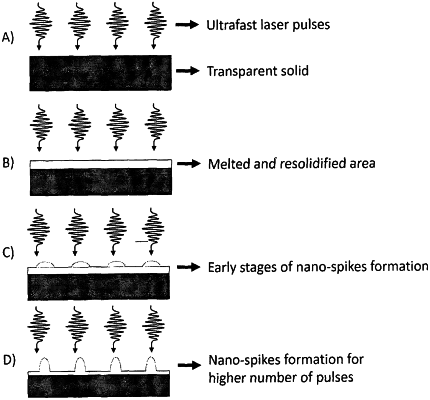| CPC B23K 26/0006 (2013.01) [B23K 26/0624 (2015.10); B23K 26/082 (2015.10); B23K 26/0861 (2013.01); B23K 26/354 (2015.10); B23K 26/3568 (2018.08); B23K 26/3584 (2018.08); B82Y 40/00 (2013.01); G02B 1/118 (2013.01); G02B 1/12 (2013.01); B23K 2101/36 (2018.08)] | 7 Claims |

|
1. A method of shaping a surface of a visibly transparent solid material to reduce reflection in the optical spectrum, comprising:
providing the visibly transparent solid material on a holder;
identifying a desired target nanostructure two-dimensional antireflection pattern array on the surface of the visibly transparent solid material;
identifying a desired focus spot distribution on the surface of the visibly transparent solid material;
identifying a melting temperature of the visibly transparent solid material;
selecting a laser fluence value in a range of laser fluence values from 1.47 J/cm2 to 3.8 J/cm2 and approaching an ablation threshold of the material;
selecting a wavelength, a repetition rate, and a pulse duration of a laser pulse from a range of wavelengths, a range of repetition rates from 1 kHz to 1 MHz, and a range of pulse durations, respectively;
selecting a number of consecutive laser pulses applied per focus spot on the surface with a pulse separation in time from 1 ps to 1 ms;
exposing the surface of the visibly transparent solid material in air to only circularly polarized laser radiation focused on the surface with the selected wavelength, pulse repetition rate pulse duration and number of consecutive laser pulses cooperating to raise the temperature of the visibly transparent solid material to approach the melting temperature of the visibly transparent solid material to shape at least a part of the surface and generate at least part of the desired target nanostructure two-dimensional pattern array, which includes nano-spikes having a height up to 300 nm; and
relatively translating the visibly transparent solid material to generate the desired nanostructure two-dimensional pattern array to form a self-assembled pseudo-periodic surface structure that is antireflective in all plane directions, wherein the visibly transparent solid material comprises at least a glass piece and is transparent to visible light.
|